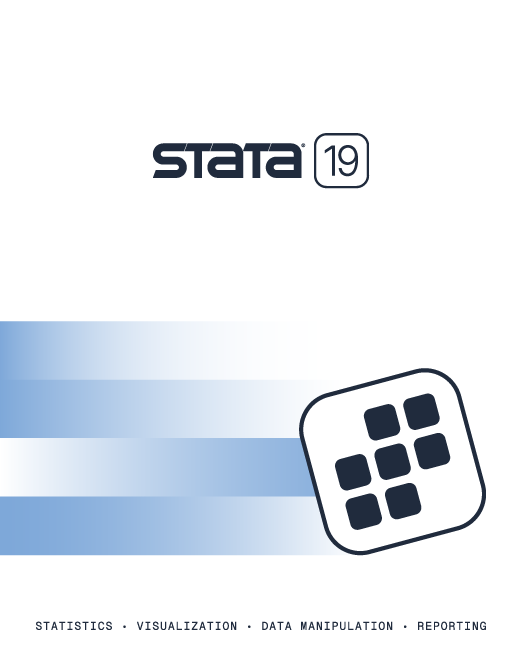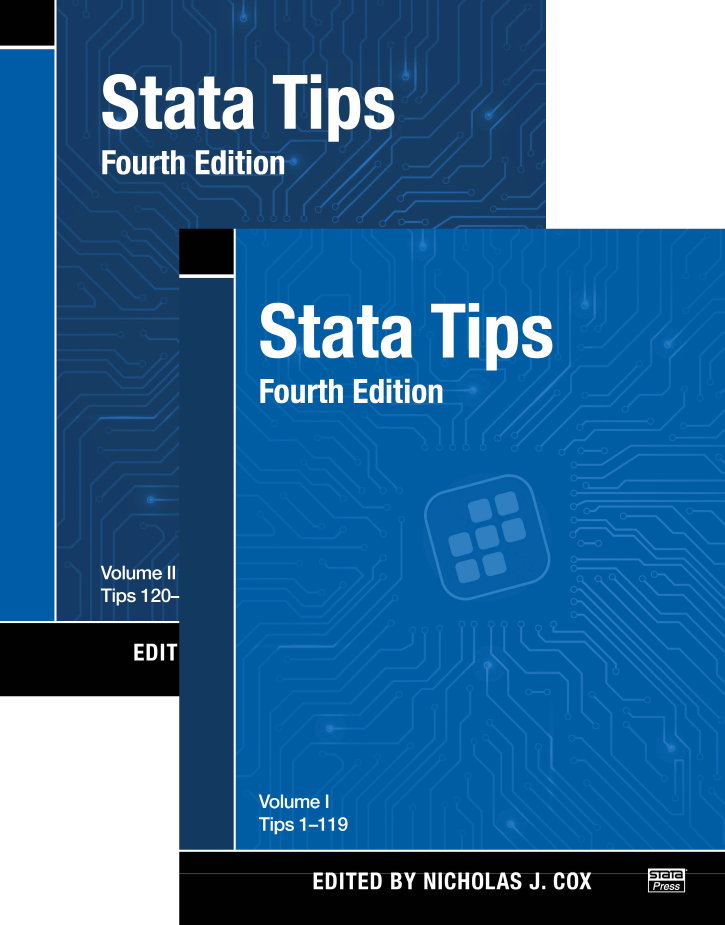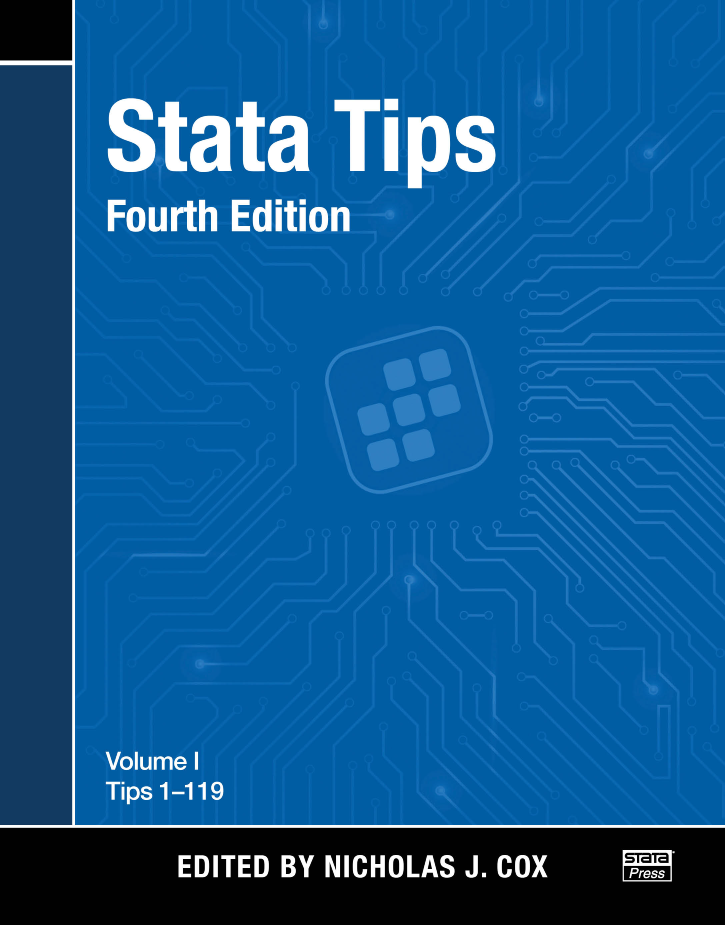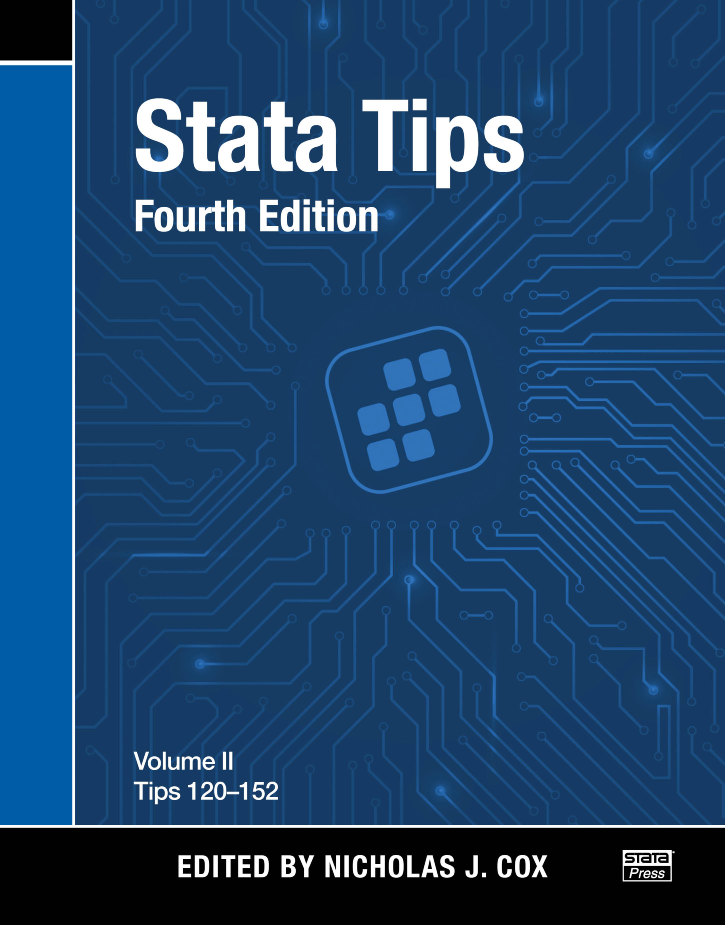

2025 Stata Conference • Nashville, TN • 31 July–01 August
Stata Tips, Fourth EditionVolume I: Tips 1–119Volume II: Tips 120–152 |
||||||||||||||||||||||||||||||||||||||||||||||||
 Click to enlarge |
$72.00 Print set Add to cart$60.00 eBook set Add to cart$57.50 Amazon Kindle set Buy from Amazon
As an Amazon Associate, StataCorp earns a small referral credit from
qualifying purchases made from affiliate links on our site.
|
|
||||||||||||||||||||||||||||||||||||||||||||||
| ||||||||||||||||||||||||||||||||||||||||||||||||
Comment from the Stata technical groupStata Tips provides concise and insightful notes about commands, features, and tricks that will help you obtain a deeper understanding of Stata. The book comprises the contributions of the Stata community that have appeared in the Stata Journal since 2003. Each tip is a brief article that provides practical advice on using Stata. With tips covering a breadth of topics in statistics, graphics, data management, and programming, both new and experienced Stata users are sure to find something that will be useful in their research. |
||||||||||||||||||||||||||||||||||||||||||||||||
About the editorNicholas Cox is a statistically minded geographer at Durham University. He contributes talks, postings, FAQ, and programs to the Stata user community. He has also coauthored 16 commands in official Stata. He was an author of several inserts in the Stata Technical Bulletin and is Editor-at-Large of the Stata Journal. |
||||||||||||||||||||||||||||||||||||||||||||||||
Table of contentsView table of contents >> Editor's preface (PDF)
Introducing Stata tips
Stata tip 1: The eform() option of regress, R. Newson
Stata tip 2: Building with floors and ceilings, N. J. Cox
Stata tip 3: How to be assertive, W. Gould
Stata tip 4: Using display as an online calculator, P. Ryan
Stata tip 5: Ensuring programs preserve dataset order, R. Newson
Stata tip 6: Inserting awkward characters in the plot, N. J. Cox
Stata tip 7: Copying and pasting under Windows, S. Driver and P. Royston
Stata tip 8: Splitting time-span records with categorical time-varying covariates, B. Jann
Stata tip 9: Following special sequences, N. J. Cox
Stata tip 10: Fine control of axis title positions, P. Ryan and N. Winter
Stata tip 11: The nolog option with maximum-likelihood modeling commands, P. Royston
Stata tip 12: Tuning the plot region aspect ratio, N. J. Cox
Stata tip 13: generate and replace use the current sort order, R. Newson
Stata tip 14: Using value labels in expressions, K. Higbee
Stata tip 15: Function graphs on the fly, N. J. Cox
Stata tip 16: Using input to generate variables, U. Kohler
Stata tip 17: Filling in the gaps, N. J. Cox
Stata tip 18: Making keys functional, S. Driver
Stata tip 19: A way to leaner, faster graphs, P. Royston
Stata tip 20: Generating histogram bin variables, D. A. Harrison
Stata tip 21: The arrows of outrageous fortune, N. J. Cox
Stata tip 22: Variable name abbreviation, P. Ryan
Stata tip 23: Regaining control over axis ranges, N. Winter
Stata tip 24: Axis labels on two or more levels, N. J. Cox
Stata tip 25: Sequence index plots, U. Kohler and C. Brzinsky-Fay
Stata tip 26: Maximizing compatibility between Macintosh and Windows, M. S. Hanson
Stata tip 27: Classifying data points on scatter plots, N. J. Cox
Stata tip 28: Precise control of dataset sort order, P. Schumm
Stata tip 29: For all times and all places, C. H. Franklin
Stata tip 30: May the source be with you, N. J. Cox
Stata tip 31: Scalar or variable? The problem of ambiguous names, G. I. Kolev
Stata tip 32: Do not stop, S. P. Jenkins
Stata tip 33: Sweet sixteen: Hexadecimal formats and precision problems, N. J. Cox
Stata tip 34: Tabulation by listing, D. A. Harrison
Stata tip 35: Detecting whether data have changed, W. Gould
Stata tip 36: Which observations?, N. J. Cox
Stata tip 37: And the last shall be first, C. F. Baum
Stata tip 38: Testing for groupwise heteroskedasticity, C. F. Baum
Stata tip 39: In a list or out? In a range or out?, N. J. Cox
Stata tip 40: Taking care of business, C. F. Baum
Stata tip 41: Monitoring loop iterations, D. A. Harrison
Stata tip 42: The overlay problem: Offset for clarity, J. Cui
Stata tip 43: Remainders, selections, sequences, extractions: Uses of the modulus,
N. J. Cox
Stata tip 44: Get a handle on your sample, B. Jann
Stata tip 45: Getting those data into shape, C. F. Baum and N. J. Cox
Stata tip 46: Step we gaily, on we go, R. Williams
Stata tip 47: Quantile–quantile plots without programming, N. J. Cox
Stata tip 48: Discrete uses for uniform(), M. L. Buis
Stata tip 49: Range frame plots, S. Merryman
Stata tip 50: Efficient use of summarize, N. J. Cox
Stata tip 51: Events in intervals, N. J. Cox
Stata tip 52: Generating composite categorical variables, N. J. Cox
Stata tip 53: Where did my p-values go?, M. L. Buis
Stata tip 54: Post your results, P. Van Kerm
Stata tip 55: Better axis labeling for time points and time intervals, N. J. Cox
Stata tip 56: Writing parameterized text files, R. Gini
Stata tip 57: How to reinstall Stata, W. Gould
Stata tip 58: nl is not just for nonlinear models, B. P. Poi
Stata tip 59: Plotting on any transformed scale, N. J. Cox
Stata tip 60: Making fast and easy changes to files with filefilter, A. R. Riley
Stata tip 61: Decimal commas in results output and data input, N. J. Cox
Stata tip 62: Plotting on reversed scales, N. J. Cox and N. L. M. Barlow
Stata tip 63: Modeling proportions, C. F. Baum
Stata tip 64: Cleaning up user-entered string variables, J. Herrin and E. Poen
Stata tip 65: Beware the backstabbing backslash, N. J. Cox
Stata tip 66: ds—A hidden gem, M. Weiss
Stata tip 67: J() now has greater replicating powers, N. J. Cox
Stata tip 68: Week assumptions, N. J. Cox
Stata tip 69: Producing log files based on successful interactive commands, A. R. Riley
Stata tip 70: Beware the evaluating equal sign, N. J. Cox
Stata tip 71: The problem of split identity, or how to group dyads, N. J. Cox
Stata tip 72: Using the Graph Recorder to create a pseudograph scheme, K. Crow
Stata tip 73: append with care!, C. F. Baum
Stata tip 74: firstonly, a new option for tab2, R. G. Gutierrez and P. A. Lachenbruch
Stata tip 75: Setting up Stata for a presentation, K. Crow
Stata tip 76: Separating seasonal time series, N. J. Cox
Stata tip 77: (Re)using macros in multiple do-files, J. Herrin
Stata tip 78: Going gray gracefully: Highlighting subsets and downplaying substrates, N. J. Cox
Stata tip 79: Optional arguments to options, N. J. Cox
Stata tip 80: Constructing a group variable with specified group sizes, M. Weiss
Stata tip 81: A table of graphs, M. L. Buis and M. Weiss
Stata tip 82: Grounds for grids on graphs, N. J. Cox
Stata tip 83: Merging multilingual datasets, D. L. Golbe
Stata tip 84: Summing missings, N. J. Cox
Stata tip 85: Looping over nonintegers, N. J. Cox
Stata tip 86: The missing() function, B. Rising
Stata tip 87: Interpretation of interactions in nonlinear models, M. L. Buis
Stata tip 88: Efficiently evaluating elastics with the margins command, C. F. Baum
Stata tip 89: Estimating means and percentiles following multiple imputation, P. A. Lachenbruch
Stata tip 90: Displaying partial results, M. Weiss
Stata tip 91: Putting unabbreviated varlists into local macros, N. J. Cox
Stata tip 92: Manual implementation of permutations and bootstraps, L. Ãngquist
Stata tip 93: Handling multiple y axes on twoway graphs, V. Wiggins
Stata tip 94: Manipulation of prediction parameters for parametric survival regression models, T. Boswell and R. G. Gutierrez
Stata tip 95: Estimation of error covariances in a linear model, N. J. Horton
Stata tip 96: Cube roots, N. J. Cox
Stata tip 97: Getting at ρ's and σ's, M. L. Buis
Stata tip 98: Counting substrings within strings, N. J. Cox
Stata tip 99: Taking extra care with encode, C. Schechter
Stata tip 100: Mata and the case of the missing macros, W. Gould and N. J. Cox
Stata tip 101: Previous but different, N. J. Cox
Stata tip 102: Highlighting specific bars, N. J. Cox
Stata tip 103: Expressing confidence with gradations, U. Kohler and S. Eckman
Stata tip 104: Added text and title options, N. J. Cox
Stata tip 105: Daily dates with missing days, S. J. Samuels and N. J. Cox
Stata tip 106: With or without reference, M. L. Buis
Stata tip 107: The baseline is now reported, M. L. Buis
Stata tip 108: On adding and constraining, M. L. Buis
Stata tip 109: How to combine variables with missing values, P. A. Lachenbruch
Stata tip 110: How to get the optimal k-means cluster solution, A. Makles
Stata tip 111: More on working with weeks, N. J. Cox
Stata tip 112: Where did my p-values go? (Part 2), M. L. Buis
Stata tip 113: Changing a variable's format: What it does and does not mean, N. J. Cox
Stata tip 114: Expand paired dates to pairs of dates, N. J. Cox
Stata tip 115: How to properly estimate the multinomial probit model with heteroskedastic errors, M. Herrmann
Stata tip 116: Where did my p-values go? (Part 3), M. L. Buis
Stata tip 117: graph combine—Combining graphs, L. Ãngquist
Stata tip 118: Orthogonalizing powered and product terms using residual centering, C. Sauer
Stata tip 119: Expanding datasets for graphical ends, N. J. Cox
Editor's preface (PDF)
Introducing Stata tips
Stata tip 120: Certifying subroutines, M. L. Buis
Stata tip 121: Box plots side by side, N. J. Cox
Stata tip 122: Variable bar widths in two-way graphs, B. Jann
Stata tip 123: Spell boundaries, N. J. Cox
Stata tip 124: Passing temporary variables to subprograms, M. L. Buis
Stata tip 125: Binned residual plots for assessing the fit of regression models for binary outcomes, J. Kasza
Stata tip 126: Handling irregularly spaced high-frequency transactions data, C. F. Baum and S. Bibo
Stata tip 127: Use capture noisily groups, R. B. Newson
Stata tip 128: Marginal effects in log-transformed models: A trade application, L. J. Uberti
Stata tip 129: Efficiently processing textual data with Stata’s new Unicode features, A. Koplenig
Stata tip 130: 106610 and all that: Date variables that need to be fixed., N. J. Cox
Stata tip 131: Custom legends for graphs that use translucency, T. P. Morris
Stata tip 132: Tiny tricks and tips on ticks, N. J. Cox and V. Wiggins
Stata tip 133: Box plots that show median and quartiles only, N. J. Cox
Stata tip 134: Multiplicative and marginal interaction effects in nonlinear models, W. H. Dow, E. C. Norton, and J. T. Donahoe
Stata tip 135: Leaps and bounds, M. L. Buis
Stata tip 136: Between-group comparisons in a scatterplot with weighted markers, A. Musau
Stata tip 137: Interpreting constraints on slopes of rank-deficient design matrices, D. Christodoulou
Stata tip 138: Local macros have local scope, N. J. Cox
Stata tip 139: The by() option of graph can work better than graph combine, N. J. Cox
Stata tip 140: Shorter or fewer category labels with graph bar, N. J. Cox
Stata tip 141: Adding marginal spike histograms to quantile and cumulative distribution plots, N. J. Cox
Stata tip 142: joinby is the real merge m:m, D. Mazrekaj and J. Wursten
Stata tip 143: Creating donut charts in Stata, A. Musau
Stata tip 144: Adding variable text to graphs that use a by() option, N. J. Cox
Stata tip 145: Numbering weeks within months, N. J. Cox
Stata tip 146: Using margins after a Poisson regression model to estimate the number of events prevented by an intervention, M. Falcaro, R. B. Newson, and P. Sasieni
Erratum: Stata tip 145: Numbering weeks within months, N. J. Cox
Stata tip 147: Porting downloaded packages between machines, R. B. Newson
Stata tip 148: Searching for words within strings, N. J. Cox
Stata tip 149: Weighted estimation of fixed-effects and first-differences models, J. Gardner
Stata tip 150: When is it appropriate to xtset a panel dataset with panelvar only? C. Lazzaro
Stata tip 151: Puzzling out some logical operators, N. J. Cox
Stata tip 152: if and if: When to use the if qualifier and when to use the if command, N. J. Cox and C. B. Schechter
| ||||||||||||||||||||||||||||||||||||||||||||||||
Learn
Free webinars
NetCourses
Classroom and web training
Organizational training
Video tutorials
Third-party courses
Web resources
Teaching with Stata
© Copyright 1996–2025 StataCorp LLC. All rights reserved.
×
We use cookies to ensure that we give you the best experience on our website—to enhance site navigation, to analyze usage, and to assist in our marketing efforts. By continuing to use our site, you consent to the storing of cookies on your device and agree to delivery of content, including web fonts and JavaScript, from third party web services.
Cookie Settings
Last updated: 16 November 2022
StataCorp LLC (StataCorp) strives to provide our users with exceptional products and services. To do so, we must collect personal information from you. This information is necessary to conduct business with our existing and potential customers. We collect and use this information only where we may legally do so. This policy explains what personal information we collect, how we use it, and what rights you have to that information.
These cookies are essential for our website to function and do not store any personally identifiable information. These cookies cannot be disabled.
This website uses cookies to provide you with a better user experience. A cookie is a small piece of data our website stores on a site visitor's hard drive and accesses each time you visit so we can improve your access to our site, better understand how you use our site, and serve you content that may be of interest to you. For instance, we store a cookie when you log in to our shopping cart so that we can maintain your shopping cart should you not complete checkout. These cookies do not directly store your personal information, but they do support the ability to uniquely identify your internet browser and device.
Please note: Clearing your browser cookies at any time will undo preferences saved here. The option selected here will apply only to the device you are currently using.


